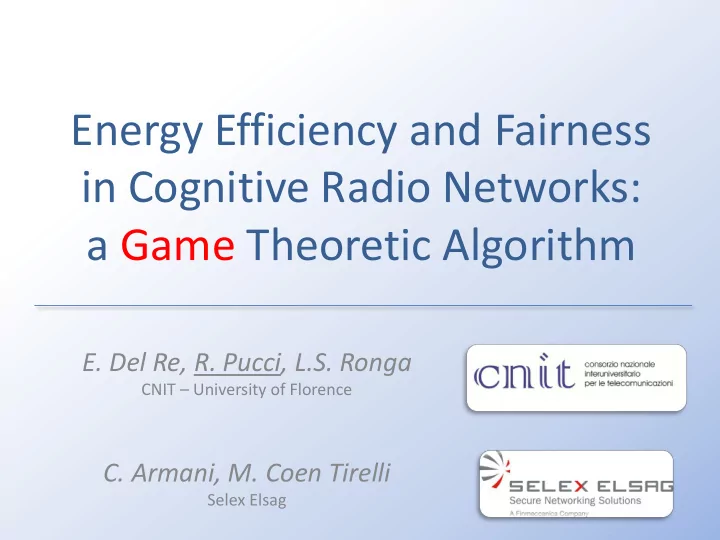

Energy Efficiency and Fairness in Cognitive Radio Networks: a Game Theoretic Algorithm E. Del Re, R. Pucci, L.S. Ronga CNIT – University of Florence C. Armani, M. Coen Tirelli Selex Elsag
Outline • Introduction • Resource allocation methods: Simulated annealing Iterative Water-Filling • Game theoretic model • Simulation results • Conclusions 6/4/2012 R. Pucci – SDR’12 WinnComm 2
SELEX Elsag 6/4/2012 R. Pucci – SDR’12 WinnComm 3
Military BU - SELEX Elsag 6/4/2012 R. Pucci – SDR’12 WinnComm 4
Possible update of SDR Platforms to COGNITIVE architectures Application Geolocation, Voice, Video, etc Policy Database Transport (Security, QoS, CR TRANSPORT PROTOCOL COGNITIVE MANAGER Power, etc) INTERFACE Network NETWORKING Link CR MAC PROTOCOL Knowledge Database (Awareness, routing, past Physical experience, RADIO SENSING etc) SDR Platform 6/4/2012 R. Pucci – SDR’12 WinnComm 5
SELEX Elsag SDR Platforms and Waveform HANDHELD Vehicular Mono-Channel SELFNET™ Soldier Broadband Waveform WIDEBAND MULTIHOP QoS VOICE/DATA SERVICES MANET 6/4/2012 R. Pucci – SDR’12 WinnComm 6
Resource Allocation (RA) Methods • Distributed (Non-Cooperative) based on Game Theory – Potential games • Common (shared) utility function – Super-modular games (w pricing) • Individual (private) utility function • Centralized (Non-Cooperative) based on Heuristics Methods – Simulated annealing – Tabu search – Genetic algorithms • Centralized (Non-Cooperative) – Water Filling – Game Theory 6/4/2012 R. Pucci – SDR’12 WinnComm 7
Simulated Annealing Fast Cooling Main features: • Stochastic heuristic method • Escaping local optima • High flexibility • At each step solution may be worst than previous solution • Optimal solution is guaranted for infinite decision time Temperature is a control parameter that decreases Slow Cooling at each step. When temperature is low, the probability of accepatence of a solution is small. In a power allocation scenario: • Complexity depends on users’ number • Algorithm is not oriented to energy efficiency 6/4/2012 R. Pucci – SDR’12 WinnComm 8
Iterative Water Filling Main features: • Halfway between modern heuristics and Game Theory • High flexibility • Quasi-Optimal solution In a power allocation scenario: • excellent performance only in weak interference environments • in strong interference environments only the user with best conditions channel should be active. • Algorithm is not oriented to energy efficiency 6/4/2012 R. Pucci – SDR’12 WinnComm 9
The scenario • 1 primary system • N secondary users (completely independent positions ) • 1 radio resource. • Discrete-time model • No "direct" cooperation among primary and secondary users “Interference Cap” REMARK Proposed scheme can be extended to include: • more than one primary user • M available radio resources (i.e. different channels or subcarriers of the same multi-carrier channel) 6/4/2012 R. Pucci – SDR’12 WinnComm 10
Fair energy efficient distributed RA based on GT 6/4/2012 R. Pucci – SDR’12 WinnComm 11
Pricing function Pricing function in red; Utility function in blue. 6/4/2012 R. Pucci – SDR’12 WinnComm 12
Speed of Convergence Thanks to the pricing parameters (b,d,m), simulations are easily tunable in terms of: • Time for convergence • Sensibility of users to interference Total utility NPcGP Total utility NPcGP t 20 40 60 80 100 20 10 000 22 20 000 24 30 000 26 40 000 50 000 28 60 000 t 5 10 15 20 25 30 70 000 6/4/2012 R. Pucci – SDR’12 WinnComm 13
Simulation Results • Convergence of the proposed system is quasi-independent from the number of users in the networks. Convergence of the utility for a 10 users Convergence of the SINR values for a 25 cognitive network. users cognitive network. 6/4/2012 R. Pucci – SDR’12 WinnComm 14
Simulation Results – SINR values • Proposed game converges to similar SINR values obtained from Simulated Annealing, generally is better than Iterative Water-Filling. Trends of SINR mean values for increasing number of secondary users in the network; SA in red, Game in blue, IWF in green. 6/4/2012 R. Pucci – SDR’12 WinnComm 15
Simulation Results – Energy Efficiency and Fairness • Proposed game is much more energy efficient than Simulated Annealing and Iterative Water-Filling, also for a large number of considered users Allocated power for a 15-user simulation; Game in (purple), SA in (purple+yellow), IWF in (purple+yellow+blue). 6/4/2012 R. Pucci – SDR’12 WinnComm 16
Simulation Results – Functional Q Functional Q: the mean value of the ratio between the SINR level received and allocated power of the transmitter, calculated for each user. Trends of SINR mean values for increasing number of secondary users in the network; Game in blue, SA in green, IWF in red. 6/4/2012 R. Pucci – SDR’12 WinnComm 17
Conclusions • Totally distributed ( no central billing system ) • Throughput fairness among autonomous Simulated Game users Annealing Theory • Misbehavior avoidance • Fast converging • Easy tunable Objective function: • Total transmission rate maximization • Total throughput maximization • Total transmit power minimization
Let’s play more! Thanks for your attention! Questions? 6/4/2012 R. Pucci – SDR’12 WinnComm 19
Recommend
More recommend